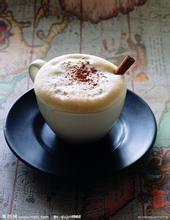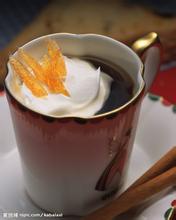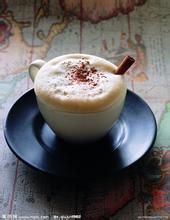Introduction of Yunnan Tieka Coffee Flavor Manor production area introduction of Yunnan Coffee Bean planting Environment
The quality of coffee depends on many factors, such as growing environment, climate, cultivation and management techniques and so on. Its excellent growth environment is low latitude, high altitude, sufficient rainfall and suitable sunshine, so the north latitude is 15. Between the Tropic of Cancer and the Tropic of Cancer is the ideal growth zone for coffee. Yunnan's planting base is located at 23 ℃ north latitude and 99 ℃ east longitude, with an altitude of 1230 meters, a height of 1540 meters, a height difference of 310 meters, mainly mountainous and sloping land, and a large undulation, fertile soil, sufficient sunshine, rich rainfall and large temperature difference between day and night. These unique natural conditions form the special taste of Yunnan coffee-strong but not bitter, fragrant but not strong, slightly fruity. The quality is similar to that of Colombian small grain coffee. Coffee fresh fruit is generally picked from November to February of the following year and processed by washing and wetting. Advanced imported equipment is used in coffee processing. At present, 30% of Yunnan coffee products are supplied to the domestic market and 70% are sold abroad. The characteristics of Yunnan coffee: due to the unique geographical environment and climatic conditions, Yunnan coffee has formed a unique flavor of strong but not bitter, fragrant but not strong, with a little fruit flavor. World-class coffee experts evaluate it as a good coffee in the world, and its cultivation techniques. Per unit yield is also world-class. Yunnan coffee is a variant of Arabian original species, which is generally known as Yunnan small seed coffee, evergreen shrub, small kernel, thick skin, sweet pulp, mellow product and low caffeine content, so it is also called light coffee. It is the main cultivated variety in the world, in addition to the origin of Ethiopia of Arabica, it is a mutant or mixed variety cultivated or found in Central and South America, India and East Africa at present. With Tibika and Bourbon as the main body, the genetic complexity is far lower than that of Ethiopia, which is the main reason for the weak physique and poor disease resistance of Arabica outside Ethiopia.
In addition, the biggest thing that bourbon and Tibica have in common is that shade trees must be "protected" to help block the sun. These two ancient varieties, such as unshaded trees, will be unfavorable to growth and flavor development bourbon (Bourbon): juxtaposed with Tibika as ancient and excellent varieties. Some botanists even believe that Bourbon is a variant of the early Tibika transplanted to Yemen, where the bean shape changed from a thin tip to a round body. It was not until 1715 that France transplanted Mocha round beans from Yemen to the island of Bourbon on the east coast of Africa, and it was not until 1715 that it received the name round bourbon. Bourbon, which spread to Brazil and Central and South America in 1727, is also round beans. In addition, the British transplant of Yemeni mocha to St. Helena Island in 1732 was also a round bean. interestingly, it did not pass through Bourbon Island, but it was named Green Top Bourbon. It can be seen that the industry thinks that all the world's bourbon beans come from Bourbon Island is a big misunderstanding. It is important to recognize that there are many round bourbon beans that spread directly from Yemen without passing through the island of bourbon. In 1881 ○, some of the round beans on Bourbon Island mutated into pointed beans, that is, the well-known "Bourbon pointed body". Its caffeine content was only half that of ordinary coffee, and its output was low and weak. The extremely rare iron pickup was also known as the old variety of small-grain coffee. Its yield was low and it was difficult to cultivate, so the price was much higher than that of ordinary small-grain coffee. Tibica coffee, native to Ethiopia and southeastern Sudan, is the most widely cultivated variety of coffee in the Western Hemisphere. The plant is stronger, but not light-tolerant, and the yield is higher in Hawaii. The top leaf of Tibika is red and copper, which is called red top coffee.

Important Notice :
前街咖啡 FrontStreet Coffee has moved to new addredd:
FrontStreet Coffee Address: 315,Donghua East Road,GuangZhou
Tel:020 38364473
- Prev

Rich and unique taste of Bolivian coffee manor area introduces the characteristics of Bolivian coffee beans
Every coffee-producing country should not be ignored, because good coffee is independent of countries. Good coffee should be shared with everyone. Although the Bolivian coffee is not well known, it is believed that the enthusiasm and seriousness of the people here are medium and low acidity, but the feeling is not monotonous, but calm and generous, soft and fresh. In the sour taste, you can even feel it.
- Next

Ecuadorian Coffee Flavor taste Manor production area introduces Ecuadorian boutique coffee beans Galapagos
In 1535, Flatoma de Belanga and others of Spain stumbled upon the Galapagos Islands. Thomas was born in 1487 on the Duro River in the province of Soria, Spain. He was the fourth bishop of Panama at that time. He was ordered to go to Peru. When his ship set sail from Panama on February 23, under the impact of a strong current, they were taken to the unknown surface of the ocean.
Related
- Detailed explanation of Jadeite planting Land in Panamanian Jadeite Manor introduction to the grading system of Jadeite competitive bidding, Red bid, Green bid and Rose Summer
- Story of Coffee planting in Brenka region of Costa Rica Stonehenge Manor anaerobic heavy honey treatment of flavor mouth
- What's on the barrel of Blue Mountain Coffee beans?
- Can American coffee also pull flowers? How to use hot American style to pull out a good-looking pattern?
- Can you make a cold extract with coffee beans? What is the right proportion for cold-extracted coffee formula?
- Indonesian PWN Gold Mandrine Coffee Origin Features Flavor How to Chong? Mandolin coffee is American.
- A brief introduction to the flavor characteristics of Brazilian yellow bourbon coffee beans
- What is the effect of different water quality on the flavor of cold-extracted coffee? What kind of water is best for brewing coffee?
- Why do you think of Rose Summer whenever you mention Panamanian coffee?
- Introduction to the characteristics of authentic blue mountain coffee bean producing areas? What is the CIB Coffee Authority in Jamaica?

